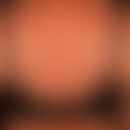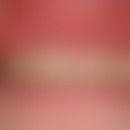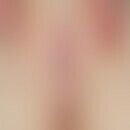DefinitionThis section has been translated automatically.
- The pathogenic importance of moulds extends mainly to the areas of secondary and opportunistic infections and to allergological phenomena (type I sensitisation, see mould allergy below), which primarily occur on the mucous membranes of the respiratory tract.
- Mould fungus infections on the skin often occur as a beneficiary of an already existing dermatophyte infection, e.g. with Tinea unguium. Here they lead to different colour changes: Scopulariopsis brevicaulis leads to a brown colour, Alternaria and Cladosporium infections to a dark to black shade. However, they can also be the primary cause of skin infections (e.g. nail mycosis or granulomatous local infections, the diagnosis of which is random).
- Among the species relevant for mould sensitization are Aspergillus, Penicillium and Cladosporium.
- Furthermore, moulds play an important role as pathogens of opportunistic infections in patients with immunosuppression and/or under long-term antibiotic therapy.
- The most frequent systemic mould mycoses are caused by species of the genus Aspergillus as well as by species from the group of zygomycetes ( Mucor, Rhizopus, Absidia), s.a. Cephalosporiosis, Verticilliosis, Hemisporosis, Peyronellaeosis, Myzetome, Chromomycosis, Black Piedra, Cutaneous Alternariosis. Less frequent are infections caused by Fusarium species (see Fusarium solani below).
TherapyThis section has been translated automatically.
S.u. and the respective clinical picture.
LiteratureThis section has been translated automatically.
- Brasch J (2012) News on diagnostics and therapy of mycoses. Dermatologist 63: 390-395
- Brasch J et al (2008) Cutaneous phaeohyphomycosis caused by Alternaria infectoria. Case report and short review. Acta Dermatovenereol 88: 160-161
Incoming links (8)
Acladiosis; Allergen; Allergen; Cephalosporiosis; Hemisporosis; Infectious diseases of the skin; Inhalation allergies, occupational; Pheohyphomycosis;Outgoing links (16)
Alternariosis cutaneous; Aspergillosis; Aspergillus fumigatus; Cephalosporiosis; Chromomycosis; Fusarium solani; Hemisporosis; Mould allergy; Mucorycoses; Myzetome; ... Show allDisclaimer
Please ask your physician for a reliable diagnosis. This website is only meant as a reference.



